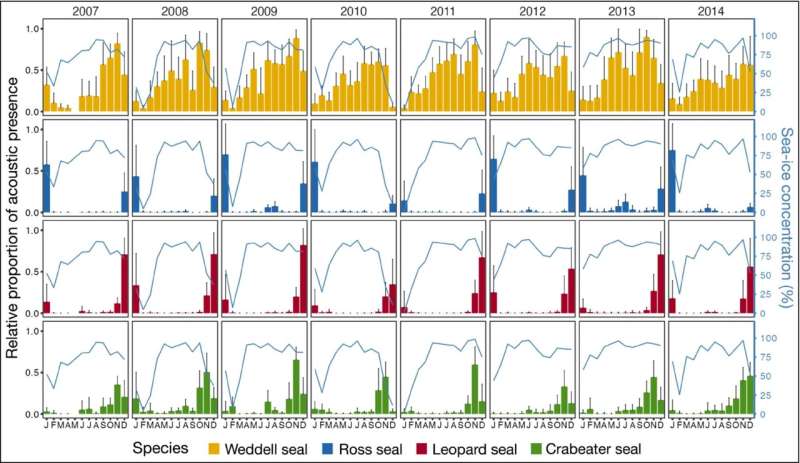This article has been reviewed according to Science X's editorial process and policies. Editors have highlighted the following attributes while ensuring the content's credibility:
fact-checked
peer-reviewed publication
proofread
Less ice means fewer calling seals, finds study

When the sea ice vanishes, Antarctic seals become silent. This is the main conclusion of a new article just published by Dr. Ilse van Opzeeland's research group in the journal Frontiers in Ecology and the Environment. The biologist is currently working at the Alfred Wegener Institute, Helmholtz Center for Polar and Marine Research (AWI) and the Helmholtz Institute for Functional Marine Biodiversity at the University of Oldenburg (HIFMB).
For the study, she and her team analyzed audio recordings from an underwater microphone that automatically recorded the vocalizations of marine mammals like seals and whales. "What's unique about our study is that, for the first time, we were able to assess recordings covering eight years and all four Antarctic seal species," says lead author Dr. Irene Roca, biologist at HIFMB and AWI at that time and currently working at the Université du Québec en Outaouais (Canada). "This allowed us to observe the seals' behavior over an extended timeframe and to compare individual years."
Among the data for the years 2007 to 2014, the turn of the year 2010/2011 particularly stands out. Back then, the research area, located in the Southern Ocean near the AWI's Neumayer Station III, was virtually ice-free: less than 10% of the usually frozen waters had ice cover. As the recordings from the underwater microphones show, there were far fewer seals in these waters at the time than in the other seven years. Antarctic seals need sea ice, because it's where they give birth and nurse their young. This takes place during spring and summer in the Southern Hemisphere, from October to January. Normally, there is extensive ice cover at this time of year, offering the seals ideal conditions for giving birth.
But in the 2010/2011 season, the ice virtually disappeared. Since the experts had only installed one underwater microphone in the area, it remains unclear whether the seals migrated during the season, and if so, to where? "However, our underwater recordings clearly show that there were far fewer calling seals than usual in the observed waters," says Irene Roca. This applies, she claims, to all seal species native to the region: the crabeater seal, Weddell seal, leopard seal and Ross seal.

The AWI experts' research area lies roughly 2,000 kilometers south of Cape Town in the Weddell Sea. The coastal region in the eastern Weddell Sea is considered particularly relevant, as it is home to all four Antarctic seal species and several species of whale. Scientists believe the region is so appealing because it offers plentiful food and (normally) good ice conditions for the seals. Accordingly, the AWI team finds its observations from the 2010/2011 season troubling: if in future, the sea-ice cover varies to such an extent more frequently due to climate change, the region will offer the seals a less reliable option as breeding ground. In this context, the SEA ICE PORTAL recently reported that the past eight years were all characterized by below-average sea-ice extents in the Antarctic and that an all-time low was reached in February 2023.
The experts can't yet say exactly how the lack of sea ice could affect seal populations, because we still know too little about the four species in question. From better studied Arctic ringed seals, it is known that this species requires sea ice with thick snow cover, which it uses to make tiny caves for its young. Studies have shown that many Arctic ringed seal pups die when there is too little sea ice and snow. "I surmise that the low-ice years also have an effect on Antarctic seals' reproduction—not only in terms of the young's survival, but possibly also the adults' mating behavior or other aspects," says project coordinator Ilse van Opzeeland.
She feels the acoustic data from the eight years represents a unique asset. Normally, gathering data on seals is extremely difficult, as they can only be counted from vessels or helicopters—and the observational radius is relatively small. Moreover, neither vessels nor helicopters can be used to seamlessly observe entire ocean regions or to continuously monitor them.
In contrast, underwater "listening posts" can keep tabs on extensive regions round the clock. In addition, since sounds travel farther underwater than in the air, depending on how loud their vocalizations are, some marine fauna can be detected from several kilometers away. Unfortunately, the AWI's Perennial Acoustic Observatory in the Antarctic Ocean (PALAOA) recently broke away from the coast together with a calving glacier. A new underwater microphone is slated for installation on the coast in the upcoming Antarctic season, starting at the end of this year.
More information: Irene T Roca et al, Sea‐ice anomalies affect the acoustic presence of Antarctic pinnipeds in breeding areas, Frontiers in Ecology and the Environment (2023). DOI: 10.1002/fee.2622
Journal information: Frontiers in Ecology and the Environment
Provided by Alfred-Wegener-Institut, Helmholtz-Zentrum für Polar- und Meeresforschung



















